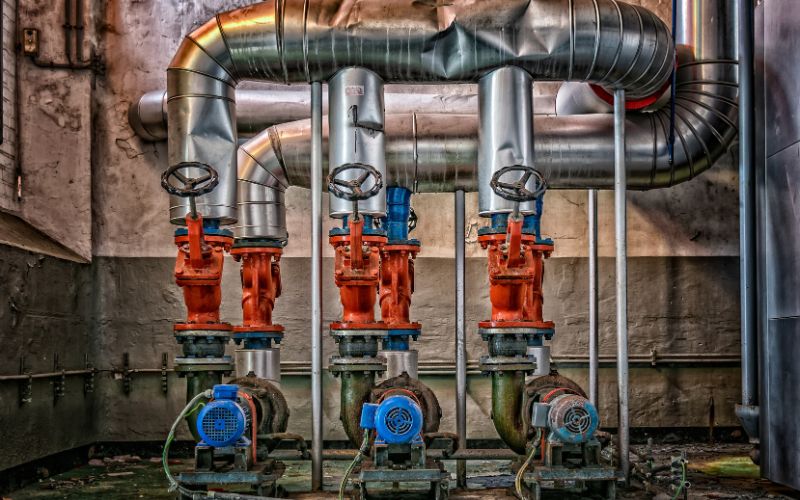Wilmington Water Quality at a Glance
15 contaminants exceed guidelines
Is Wilmington Water Safe to Drink?
Federally Compliant with Significant Concerns – Wilmington water meets EPA standards but contains 15 contaminants exceeding health guidelines. Primary issues include PFOA at 7.05 ppt (above the 4 ppt EPA limit), extensive chlorine disinfection byproducts, and chromium-6. The Brandywine Creek source water has the highest susceptibility to contamination from pathogens, metals, and industrial pollutants. Delaware’s Red Clay Creek shows PFAS levels up to 135 ppt.
⚠️ Key Concerns for Wilmington Residents
- PFAS “Forever Chemicals”: PFOA detected at 7.05 ppt, exceeding new EPA limit of 4 ppt; Delaware statewide PFAS contamination affecting multiple watersheds
- Disinfection Byproducts: Multiple cancer-causing chemicals formed during chlorine treatment, including trihalomethanes at 254x above health guidelines
- Source Water Vulnerability: Brandywine Creek has highest contamination susceptibility; 72 identified pollution sources in Pennsylvania watershed
- Emerging Contaminants: Chromium-6 at 16x guidelines, nitrates from agricultural runoff, and ongoing taste/odor issues from algal blooms
Read the full report below for detailed analysis, city-specific data, and actionable recommendations for Wilmington residents.
Wilmington – Delaware – Water Quality Report 2025: PFAS Testing, Infrastructure Concerns & Safety across your city
Wilmington Water provides comprehensive water and wastewater services to over 110,000 residents across the City of Wilmington and surrounding areas in northern New Castle County, Delaware. Dating back to the 1800s, this municipal utility serves approximately 39,000 customer accounts through extensive infrastructure including water distribution lines, treatment facilities, and pumping stations that deliver drinking water daily to Delaware’s largest city and surrounding communities.
Wilmington sources its drinking water primarily from the Brandywine Creek, which has been determined to have the highest susceptibility to contamination from pathogens and metals. The water is treated at multiple facilities including advanced treatment plants. While Wilmington’s water consistently meets federal and state quality standards, the utility faces ongoing challenges with emerging contaminants like PFAS (with PFOA detected at 7.05 ppt, exceeding the new 4 ppt EPA limit), disinfection byproducts, and the need for lead service line replacement. The utility has implemented significant investments in treatment technology and system modernization to address these challenges.

Wilmington Water Quality: Current Status (2024-2025)
Latest Testing Results
- PFAS Detection: PFOA detected at 7.05 ppt, exceeding the new EPA limit of 4 ppt; multiple PFAS compounds found including PFBA (7.30 ppt), PFHxA (9.49 ppt), and PFPeA (11.7 ppt).
- Disinfection Byproducts: Multiple cancer-causing trihalomethanes detected at 254 times above health guidelines, including chloroform (26.2 ppb) and haloacetic acids (43.0 ppb).
- Compliance Status: Wilmington’s water meets federal drinking water standards for the latest quarter assessed (April-June 2024), though 15 contaminants exceed EWG health guidelines.
Water Sources
- Brandywine Creek: Primary source with the highest susceptibility to contamination from pathogens and metals, spanning portions of three Pennsylvania counties with 72 identified pollution sources in the watershed.
- Source Water Vulnerability: Red Clay Creek in the region shows PFAS levels as high as 135 ppt, demonstrating widespread contamination challenges affecting the broader Delaware watershed system.
- Watershed Challenges: The Brandywine Creek watershed faces contamination from industrial discharges, stormwater runoff, agriculture, and underground storage tanks throughout the multi-state drainage area.
Treatment Technology
- Current Treatment: Water treatment facilities utilize conventional treatment processes including chlorination, which creates disinfection byproducts like trihalomethanes and haloacetic acids detected in the system.
- PFAS Treatment Needs: Current treatment does not effectively remove PFAS compounds, with PFOA levels exceeding new EPA standards requiring future treatment upgrades by 2029.
- Emerging Contaminant Monitoring: Ongoing testing under EPA’s Unregulated Contaminant Monitoring Rule 5 (UCMR5) for 29 PFAS compounds to assess contamination levels and treatment needs.
Infrastructure Concerns
- Lead Service Lines: Service line inventory completed with lead and galvanized lines requiring replacement under federal regulations, with replacement plans being developed.
- System Improvements: Ongoing investments needed to address aging infrastructure, improve treatment capabilities for emerging contaminants, and maintain system reliability.
- Rate Increases: Wilmington implemented 5.7% annual rate increases through 2027 to fund infrastructure improvements and regulatory compliance, affecting 39,000 customer accounts.
Customer Protection Initiatives
Wilmington Water provides customer support through various programs while addressing water quality challenges. The utility maintains compliance with current federal standards and provides annual water quality reports for transparency. However, residents should be aware that legal compliance does not necessarily mean water meets the latest health guidelines, as legal limits for many contaminants have not been updated in almost 20 years. The city has launched WilmingtonDEWater.gov to improve customer service and access to water quality information. Educational outreach helps residents understand water quality issues and the importance of home filtration for additional protection against contaminants like PFAS and disinfection byproducts that exceed health guidelines.
Recommendations for Wilmington Residents

Check Your Service Lines
Complete Wilmington’s service line survey at WilmingtonDEWater.gov to help identify materials in your home’s plumbing. Free lead testing is available by contacting (302) 576-2620 or emailing waterqualitylab@wilmingtonde.gov.

Conserve Water
Take advantage of Wilmington’s conservation programs and follow water-saving practices. The city has invested in green infrastructure projects including wetlands restoration and stormwater management systems to protect water resources.

Consider Home Filtration
Given that PFOA levels exceed EPA standards and 15 contaminants exceed health guidelines, NSF-certified activated carbon or reverse osmosis filters are recommended for drinking and cooking water to reduce PFAS and disinfection byproducts.

Manage Your Account Online
Visit WilmingtonDEWater.gov to pay bills, set up automatic payments, track water usage, and access educational information about water quality and conservation programs. Monthly billing helps manage costs and identify leaks faster.

Report Issues
Contact Wilmington 311 at (302) 576-2620 for water emergencies, pressure problems, or quality concerns. Report leaks promptly to help conserve water and maintain system integrity throughout the distribution network.
Frequently Asked Questions
Is Wilmington’s tap water safe to drink?
Wilmington’s tap water meets all federal and state drinking water standards. However, the water contains PFOA at 7.05 ppt, which exceeds the new EPA limit of 4 ppt, and 15 contaminants exceed health guidelines set by environmental health experts.
The water comes from the Brandywine Creek, which has been identified as having the highest susceptibility to contamination from pathogens and metals. While treatment processes provide multiple barriers against many contaminants, the presence of PFAS and disinfection byproducts at levels above health guidelines suggests that additional protection through home filtration may be beneficial for concerned residents.
Why are water bills increasing in Wilmington?
Wilmington has implemented structured rate increases of 5.7% annually through 2027 to fund critical infrastructure improvements:
1. Infrastructure modernization: Replacing aging water mains, upgrading treatment facilities, and modernizing pumping stations
2. Regulatory compliance: Future PFAS treatment systems required by 2029 and lead service line replacement as mandated by federal regulations
3. Service improvements: Supporting system reliability while addressing emerging contaminant challenges and maintaining compliance
The utility serves approximately 39,000 customer accounts and has increased funding for the Water Utility Assistance Program to help qualifying residents manage costs during this transition period.
Does Wilmington have lead in its water system?
Wilmington has completed a service line inventory as required by federal regulations:
• Service line assessment: The city is working to identify and replace lead and galvanized service lines under new federal requirements
• Lead-free at source: Water is lead-free when it leaves treatment plants; any lead exposure would come from service lines or internal building plumbing
• Replacement requirements: Under the EPA’s Lead and Copper Rule Revisions, utilities must replace lead service lines within prescribed timeframes
• Customer assistance: Free testing and educational resources are available to help residents understand potential lead exposure risks
Homes built before 1988 have higher likelihood of containing lead plumbing components, which is why testing and customer assistance programs are important for resident protection.
What is Wilmington doing about PFAS?
Wilmington is addressing PFAS contamination to meet upcoming EPA regulations:
Current situation:
• PFOA detected at 7.05 ppt, exceeding the new EPA limit of 4 ppt effective in 2029
• Multiple PFAS compounds detected in the water supply system
• Current treatment technology does not effectively remove PFAS compounds
Compliance planning:
• Water systems must meet EPA’s 4 ppt limit for PFOS and PFOA by 2029
• Treatment system upgrades will be required to achieve compliance
• Ongoing monitoring under EPA’s Unregulated Contaminant Monitoring Rule 5 to assess contamination levels
Quality News About Your Water
Get the comprehensive water quality news coverage you need with our dedicated US Water News Service. From coast to coast, we deliver in-depth reporting and expert analysis on PFAS contamination, EPA regulatory changes, infrastructure developments, and emerging water safety issues affecting communities nationwide. While mainstream media only covers the biggest stories, we provide the detailed, ongoing coverage that helps you understand the full scope of America’s water challenges. Whether you’re a concerned citizen, water professional, or community leader, our daily updates and analytical insights keep you informed about the issues that matter most to public health and environmental safety.
Contaminants of Concern

PFAS Compounds
Source: Per- and polyfluoroalkyl substances from industrial processes, firefighting foams, and consumer products that enter source waters from upstream industrial activities and atmospheric deposition
Health Effects: Research suggests potential impacts on immune system, thyroid function, cholesterol levels, liver function, and possible links to certain cancers; endocrine disruption and developmental harm
Current Levels: PFOA detected at 7.05 ppt (exceeding 4 ppt EPA limit); PFBA at 7.30 ppt; PFHxA at 9.49 ppt; PFPeA at 11.7 ppt EPA Limits: 4 ppt for PFOS and PFOA, with compliance required by 2029

Disinfection Byproducts
Source: Cancer-causing chemicals formed when chlorine and other disinfectants react with organic matter in source water during the treatment process
Health Effects: Trihalomethanes and haloacetic acids increase cancer risk and may cause problems during pregnancy; potential liver damage and reproductive issues
Current Levels: Total trihalomethanes at 38.1 ppb (254x above health guideline); chloroform at 26.2 ppb; haloacetic acids at 43.0 ppb Legal Status: Meets federal limits but exceeds health guidelines
Please read – our information
The information presented on cleanairandwater.net is compiled from official water quality reports, trusted news sources, government websites, and public health resources. While we strive for accuracy and thoroughness in our presentations, we are not scientists, engineers, or qualified water quality professionals.
Our mission is to present water quality information in an accessible, real-world format that helps people understand what’s in their water and make informed decisions about their health and safety. We believe that complex environmental information should be available to everyone in a format that’s easy to understand.
We make every effort to ensure our content is current and accurate, but we cannot guarantee that all information is complete or error-free. This website should not replace official communications from your local water utility or health department. We always recommend consulting official sources for the most up-to-date information regarding your specific water system.
Clean Air and Water is not liable for any unintentional errors, omissions, or outdated information. The content on this site is provided for informational purposes only and should not be considered professional advice.


